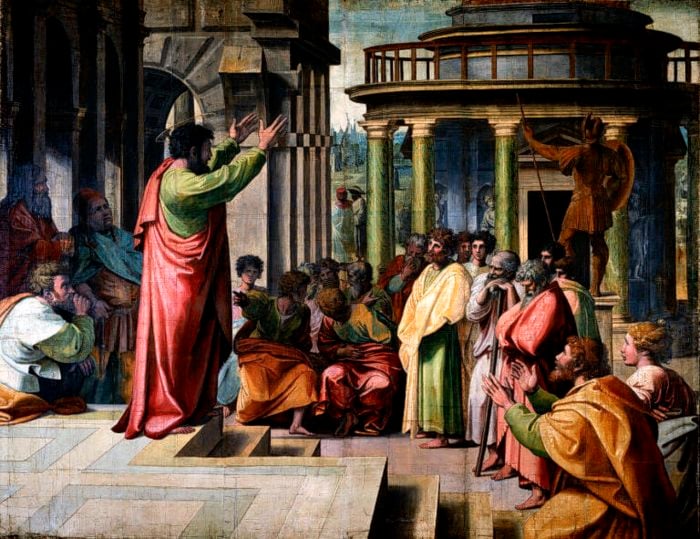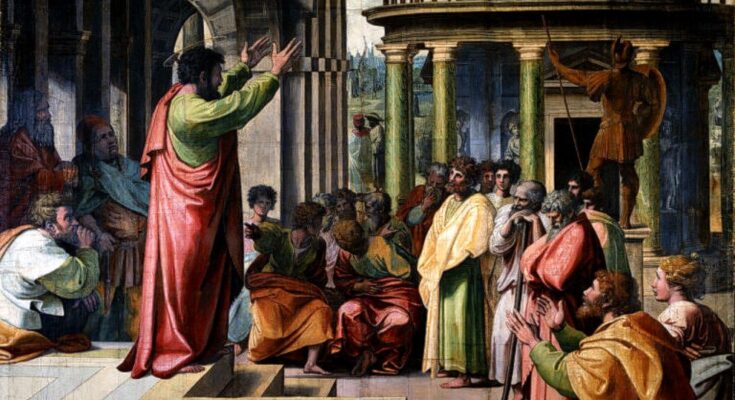
Saint Paul made two missionary journeys to Greece, bringing Christianity to its people; from there, it spread quickly throughout Western European.
Paul the Apostle, commonly known as Saint Paul, is considered one of the most important Apostles in the spreading the teachings of Jesus in the first century world.
According to the New Testament book Acts of the Apostles, Paul was sent on three separate missions to spread the word of Jesus to the rest of the world.
Saint Paul travels to Greece
Saint Paul traveled to Greece for the first time on his second missionary tour, arriving from Troy in Asia Minor—today’s Turkey. The year was around 49 AD.
According to the narrative of the Acts of the Apostles in the New Testament, the occasion was a vision Paul saw one night while he was in Troy.
In the vision, a Macedonian man stood in front of him and begged him to go across the Aegean and further on to Macedonia to bring the word of Christ to its people.
Both Saint Paul himself and his associates saw this vision as an invitation from the Lord to preach his Gospel in that area of Greece.
Obeying the divine command, Paul and his associates headed by ship from Troy to Samothrace and, from there, to Neapolis, now called Kavala.
From Kavala, the mission headed on foot to the city of Philippi. After a relatively short stay there, St. Paul and his associates followed the Egnatia Odos through Amphipolis
and Apolloniada for Thessaloniki, where they preached for three days.
Local Jewish people in Thessaloniki were not keen on hearing Paul preach and tried to force the group out of the city. After being detained, they were let go, and left for Veria.
In Veria, the people were much more amenable to Paul’s message, but, when the same group from Thessaloniki heard Paul was there, they arrived in the town and tried to stir up the local people, so Paul subsequently left.
Saint Paul in Athens, Greece
The next stop for the great Apostle was the famous city of Athens to which St. Paul arrived by sea.
Athens, home of Plato’s Academy and Aristotle’s Lyceum, the cradle of Western civilization, and the birthplace of democracy, was past its prime by the time the Apostle visited the city.
The Apostle went to the Agora several times, where he was not met by eager listeners. The predominantly pagan audience was not responsive to his words on the Resurrection of Jesus.
Some Athenians took Paul to a meeting at the Areopagus, the high court of Athens, where he was able to preach and even held discussions with Epicurean and Stoic philosophers.

It was for the first time there that the nature of Jesus Christ and Christianity was presented to a pagan, yet well-educated, audience.
Saint Paul explained the ignorance behind worshipping pagan idols. He explained the meaning of one God, the Creator of all, and His relationship to humanity and called on his audience to know God instead of worshipping “an unknown god,” as they did — seemingly aware that there must be some other presence out there that was not represented by pagan deities.
Some Athenians immediately became followers of the Apostle, opening the way to the conversion of more people to the new, true faith.
The place where St. Paul preached on the hill of the Areopagus, just at the base of the Acropolis, is marked today with a bronze plaque, inscribed with the words he used to relate the story in the Bible (in Greek).
From Athens to bustling Corinth
Following the decline of Athens, the commercial and political center of Greece under Rome had shifted to Corinth, just 52 miles (84 kilometers) west of Athens.
St. Paul’s mission in Greece continued with him going to Corinth where he spent eighteen months proselytizing to the pubic. There, he met and worked with the Jewish tentmakers Aquila and Priscilla, who are mentioned in the Bible.
During his stay, he reasoned and preached the Gospel to the Jews of the city, being confronted, however, with strong opposition from members of the city’s large Jewish community.
Nevertheless, St. Paul founded the church in Corinth. From there, he moved on to Ephesus, a city on the west coast of today’s Turkey, and then to Caesarea and Antioch to complete his mission.
The Apostle later returned to Ephesus on his third missionary journey and stayed there for three years.
During his time in Ephesus, St. Paul received disconcerting news from Corinthian Christians regarding rivalries, jealousy and immoral behavior. His congregation requested advice to solve such problems.
St. Paul’s First Epistle to the Corinthians addresses the issues of division, morality, personal disputes, sexual purity, marriage, and the correct form of Christian worship, and offers solutions based on the teachings of Jesus.
Saint Paul makes second missionary visit to Greece
St. Paul returned to Greece twice as part of his third missionary journey.
After his First Epistle to the Corinthians failed to have the desired results, St. Paul wrote the Second Epistle to the Corinthians, from Macedonia, in the year 55 or 56 AD.
In the second letter, he affirms his affection for the Corinthians, while stating the importance of forgiving others, and the importance of being a person who reflects Christ and gives generously to God’s people.
The Apostle instructs the faithful on the collection for the poor in the Jerusalem church, and concludes with a polemic defense of his apostleship.
However, neither of the two epistles had the desired results, and Paul the Apostle eventually made a brief visit to Corinth in the spring of 56 AD.
In the winter of the same year, St. Paul visited Philippi. There he heard the good news from Corinth that led him to send a Third Epistle to the Corinthians to correct alleged misinterpretations of the earlier two.
After Philippi, St. Paul headed for southern Greece by sea, via Nikopolis, a large port of that time, which today is located close to the city of Preveza.
From there, the Apostle seems to have boarded a ship that ended up in Lechaio, the port of Corinth in the Corinthian Gulf.
It is during St. Paul’s stay in Corinth that he wrote his famous Epistle to the Romans, aiming to prepare for his hoped-for journey not only to the city of Rome, but from there and further west, to what is now Spain.
St. Paul stayed in Corinth for three months this time.
Saint Paul heads back to northern Greece
St. Paul’s next destination was the city of Jerusalem. However, the uncovering of a plot to be assassinated by some Jews on his way back forced him to change his plans.
Instead of boarding a ship for one of the ports in Palestine, the Apostle turned North and headed back to Macedonia and the city of Philippi.
From there, he headed to Jerusalem, making intermediate stops in Mytilene, Chios (Oinousses), Samos, Kos, Rhodes, and other islands.



